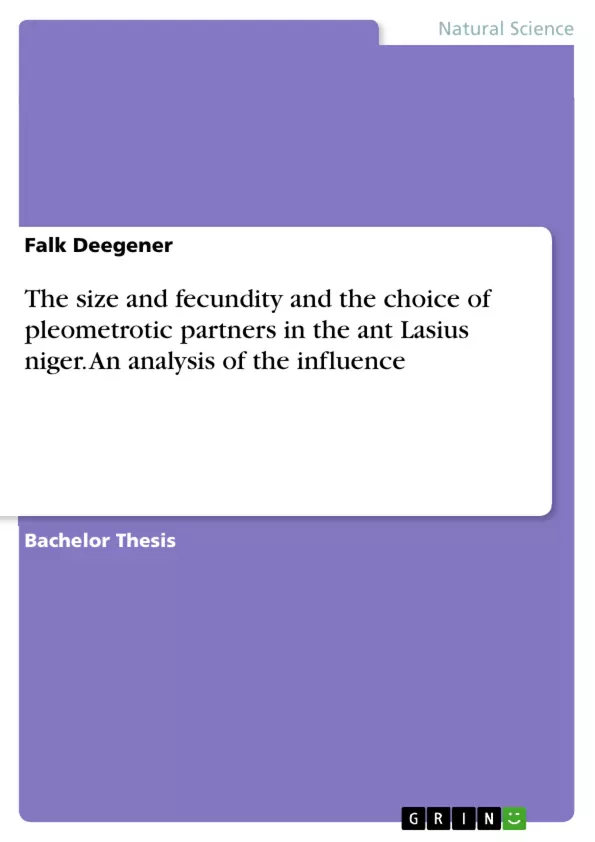This paper deals with the hypothesis, that there is a mechanism in Lasius niger queens giving them the ability to assess the fecundity of another queen, probably through CHC’s. The thorax length likely does not contribute to this mechanism.
Cooperation between unrelated individuals provides benefits that could ensure the survival of species. This work investigates on pleometrotic choosing behavior in Lasius niger ant queens. Here, two or more unrelated and usually monogynous queens found a colony together right after their nuptial flight and cooperate up to the emergence of the first workers.
Then they fight until only one of them remains. Since the surviving queen is usually more fecund and heavier than her former nestmates, it is hypothesized that she will choose smaller queens with a lower fecundity to cooperate with. Therefore, queens in special arenas with two opposite arranged branches were given different choices.
Here, either both branches contained a queen of higher or lower fecundity or only one of them. Two different experiments were performed, where the queens were either grouped random or based on their fecundity. It was found that queens that were chosen over another queen later laid significantly less eggs than the rejected ones.
Additionally, queens that chose a lower fecund queen were significantly faster at choosing than queens that chose a higher fecund one. Queens that chose a queen over an empty nest site also did this faster than queens that chose an empty nest site over a queen. There was no significant difference in thorax length between chosen and rejected queens.
The differences in relative thorax length were only significant in one of two collection locations, where chosen queens were larger than rejected ones.
Inhaltsverzeichnis (Table of Contents)
- Abstract
- Introduction
- Cooperation Between Individuals
- Altruism
- Pleometrosis
- Questions and Hypotheses
- Material and Methods
- Lasius niger
- Collection and Storing
- Decision Experiments
- Random Grouping
- Fecundity-based Grouping
- Analysis
- Results
- The Influence of Fecundity
- The Influence of Size
- The Impact on Choosing Time and Chamber Visits
- Discussion
- Primary Study Goals
- Fecundity as a Driving Factor in Pleometrotic Choice
- Size does not Matter (mostly)
- All in Good Time
- Evolutionary Aspects
- Error Analysis
- Bibliography
Zielsetzung und Themenschwerpunkte (Objectives and Key Themes)
This study investigates the choosing behavior of pleometrotic Lasius niger ant queens. The research aims to understand how these queens choose their partners for colony founding. Specifically, the study focuses on the role of fecundity and size in determining partner selection.
- Pleometrotic behavior in Lasius niger ant queens.
- The influence of fecundity on partner selection.
- The role of size in queen choice.
- The evolutionary significance of partner selection strategies.
- The mechanism by which queens assess fecundity in potential partners.
Zusammenfassung der Kapitel (Chapter Summaries)
The introduction provides a comprehensive overview of cooperation and altruism in animal behavior, with particular focus on the social system of ants. The study's research question and hypotheses are presented in detail. The material and methods section outlines the experimental setup and the criteria for selecting and grouping the ant queens. The results section presents the findings of the experiments, focusing on the influence of fecundity and size on partner choice. This section also examines the timing of partner selection and the number of visits to potential partner chambers. The discussion section analyzes the study's findings in relation to the hypotheses, providing insights into the underlying mechanisms of queen choice and its evolutionary implications. Error analysis is also included.
Schlüsselwörter (Keywords)
The primary keywords and focus topics of this work include pleometrosis, Lasius niger, ant queens, partner choice, fecundity, size, colony founding, cooperation, altruism, inclusive fitness, and evolutionary biology.
- Quote paper
- Falk Deegener (Author), 2021, The size and fecundity and the choice of pleometrotic partners in the ant Lasius niger. An analysis of the influence, Munich, GRIN Verlag, https://www.grin.com/document/1131601



